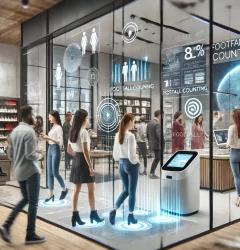Video Analytics
Retail Analytics in 2024: Integrating People Counting with Big Data for Deeper Insights
09 Apr

Retail Analytics in 2024: Integrating People Counting with Big Data for Deeper Insights
As we step into 2024, the retail landscape continues to evolve at an unprecedented pace, driven by technological advancements and changing consumer behaviors. Among the key trends shaping the future of retail, the integration of people counting technologies with big data analytics stands out as a transformative strategy for businesses aiming to thrive in a highly competitive market. This synergy not only enhances customer understanding but also propels retail operations to new levels of efficiency and personalization.
The Evolution of People Counting
People counting, once a straightforward tactic for measuring foot traffic, has evolved into a sophisticated analytical tool. Modern people counters leverage cutting-edge technologies such as AI, machine learning, and computer vision, offering unparalleled accuracy in tracking customer movements, dwell times, and even emotions. However, the true potential of people counting is unlocked when combined with big data analytics. This integration allows retailers to correlate foot traffic data with a myriad of other data points, including sales transactions, online behavior, weather conditions, and economic indicators, to glean comprehensive insights into consumer patterns.
The Power of Integrated Analytics
Integrating people counting data with big data analytics enables retailers to perform multidimensional analyses of consumer behavior. For instance, by analyzing foot traffic alongside sales data, retailers can identify not just the busiest times, but also the most profitable periods. This insight can inform staffing decisions, promotional planning, and inventory management, ensuring that resources are allocated efficiently to meet demand. Furthermore, combining in-store behavior data with online analytics helps retailers understand the omnichannel customer journey, facilitating a seamless shopping experience that boosts loyalty and satisfaction. The benefits of this integrated approach extend beyond operational efficiencies. Personalized marketing campaigns, tailored product recommendations, and optimized store layouts are just a few examples of how deep insights can enhance the customer experience. Moreover, predictive analytics, powered by big data and people counting, allows retailers to anticipate trends and consumer needs, staying ahead of the curve in product development and strategic planning.
Navigating Challenges and Opportunities
The fusion of people counting technologies with big data analytics brings with it a host of benefits, yet it is not without its hurdles. Foremost among these challenges are the issues of data privacy and security. In an era where consumer data protection is under intense scrutiny, retailers are tasked with the delicate balance of leveraging customer data for insights while adhering to stringent data protection regulations. This necessitates a thorough understanding and compliance with the intricate regulatory framework that governs customer data usage, ensuring that customer privacy is not just respected, but prioritized. Moreover, the vast amount of data generated through people counting and big data analytics can be as daunting as it is valuable. The complexity and volume of this data require retailers to make significant investments in advanced analytics platforms capable of processing and analyzing data at this scale. Additionally, to truly capitalize on the depth of insights offered by integrating people counting with big data, retailers must also seek out and employ professionals who possess the specialized skills to navigate these complex data landscapes. These skilled analysts are crucial for interpreting the data accurately and transforming it into actionable strategies that drive business growth. In essence, while the amalgamation of people counting systems with big data analytics promises to redefine the retail industry by offering deeper insights into consumer behavior, it also demands a sophisticated approach to data management and analysis. Retailers embarking on this journey must be prepared to invest in both the technological infrastructure and the human expertise required to navigate the challenges of data privacy, security, and complexity. Only then can they fully harness the immense potential of integrated data analytics to inform business strategies and foster customer-centric innovation.
The Impact of AI People Counting
AI people counting represents a significant leap forward in the way businesses, particularly in the retail sector, understand and interact with their customer base. This technology harnesses the power of artificial intelligence to accurately track and analyze foot traffic within physical spaces. Unlike traditional people counting solutions that may simply tally the number of visitors, AI-driven systems are capable of much more nuanced and detailed analysis, including recognizing repeat customers, analyzing shopping patterns, and even predicting customer behavior based on historical data. The real strength of AI people counting lies in its ability to process and interpret complex data sets in real time. By utilizing advanced algorithms and machine learning models, these systems can differentiate between employees and customers, track the direction of movement, and identify the most visited areas within a store. This level of detail provides retailers with actionable insights into how customers interact with their space, which products attract the most attention, and how changes in store layout or product placement can affect customer flow. Consequently, retailers can optimize the shopping experience, improve store layouts, and tailor their marketing strategies to match customer preferences and behaviors, ultimately enhancing sales and customer satisfaction. Moreover, the integration of AI people counting with other technological solutions, such as CRM systems and sales data analytics, offers a holistic view of the customer journey, from entry through to purchase. This integration enables businesses to craft highly personalized marketing campaigns and improve operational efficiency, such as optimizing staffing levels to match peak times. However, the adoption of AI people counting also raises important considerations around privacy and data security. Businesses must ensure that their use of this technology complies with data protection regulations and respects customer privacy. Despite these challenges, the benefits of AI people counting, from improving customer experiences to providing deep analytical insights, make it a valuable tool in the arsenal of modern retail management.
In conclusion, as we move further into 2024, the integration of people counting with big data stands as a beacon of innovation in retail analytics. This powerful combination provides retailers with the deep insights needed to make informed decisions, optimize operations, and deliver personalized customer experiences. By embracing this integrated approach, retailers can not only survive but thrive in the dynamic and ever-changing retail environment of 2024. The future of retail is not just about counting people; it’s about understanding them, anticipating their needs, and creating value at every touchpoint.
Related Post
Tags
Keywords
Tags
Resources
© 2020-2024 Link Retail. All rights reserved.











